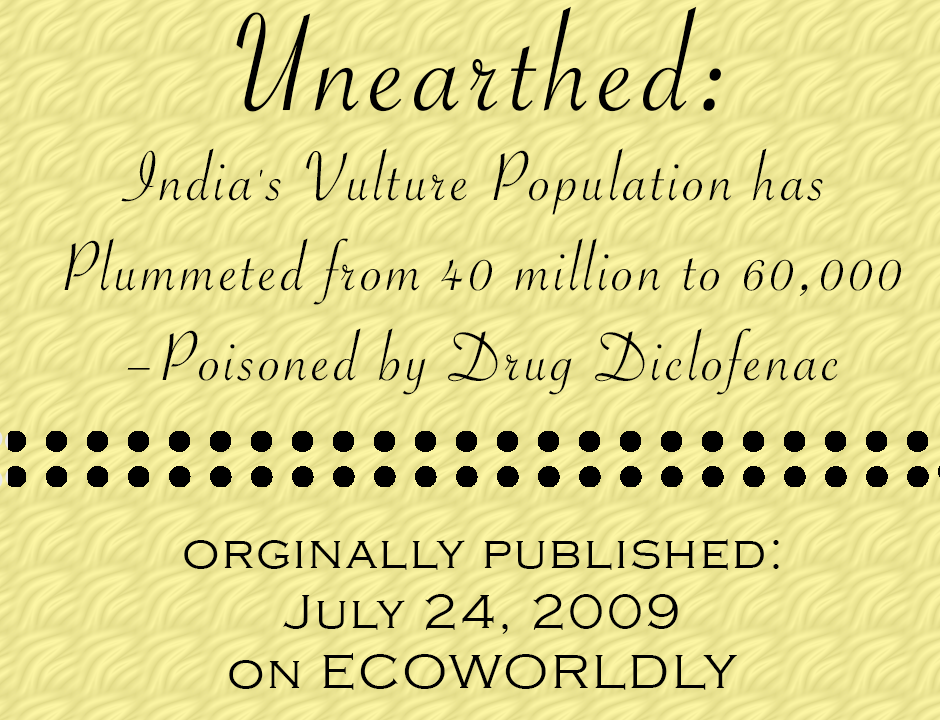
Three species of Gyps vulture are in danger of extinction – poisoned by the use of diclofenac in livestock. India, Nepal, and Pakistan have lost 95% of their vulture populations.
As recently as the early 1980’s, there were approximately 40 million vultures in India.
However, in the late 1990’s, the Bombay Natural History Society (BNHS) noticed population declines in a breeding colony of White-backed Vultures in Keoladeo National park, Bharatpur, Rajasthan.
By 2000, there were no breeding pairs left.
Scientific community rallies around vultures
In the meantime, the scientific community rallied around a Vulture Alert issued in 1998, and further studies were launched across additional raptor populations.
The findings of the BNHS, Royal Society for Protection of Birds-UK (RSPB) and Zoological Society of London (ZSL) found strong evidence that use of diclofenac (an anti-inflammatory drug) in livestock was poisoning the vultures.
In the course of treatment, if the cattle dies, and the vultures scavenge on these, it leads to the dehydration, visceral gout, and kidney failure in vultures within a few days. Experimentally it is established that even if less than 1% carcasses contains diclofenac, it can lead to such a drastic decline. The grim picture is that over 10% of the carcasses have prevalence of diclofenac.
The reason for the widespread use of diclofenac in livestock is an unpleasant one. Use of the painkiller is said to make “unbearable” living conditions for these domestic animals “tolerable.”
Ban on use of diclofenac
Based on the overwhelming scientific evidence, BNHS launched a rigorous campaign against diclofenac in 2003, urging the Government of India to ban the its use, in an urgent plea to save the remaining vultures from extinction.
In May 2006, the Indian Government ordered a “halt to the production and sale of the veterinary drug diclofenac within three months.”
An alternative drug, Meloxicam, was found to have no adverse reactions in vultures.
Captive breeding programs to save vultures
Dr. Vibhu Prakash, the principal scientist for the vulture conservation breeding program at the Bombay Natural History Society recently told the Asia Sentinel:
By bringing some vultures into captivity, their lives can be saved and once they start breeding, they would augment the population. The vultures will be released back in the wild once we are sure that there is no diclofenac available in the system.
Vulture breeding centers are operating at Pinjore in Haryana, Rajabhatkhawa in West Bengal and Rani in Assam, supported by the Royal Society for the Protection of Birds (UK), the Zoological Society of London and the Peregrine Fund (US).
The Pinjore center has 120 vultures and Rajabhatkhawa centre has 76 vultures of three species, the Rani center 30 of two species.
Captive breeding of vultures has been met with some opposition because of the requirement that nestlings and sub-adults are to be collected from wild populations.
Vultures are extremely difficult to breed in captivity. They mate for life, and produce just one chick per year, after maturing at four years of age.
Recently, a Slender-billed Vulture (Gyps tenuirostris) made history as the first of its kind to be born in captivity. The chick was hatched at the breeding center at Rajabhatkhawa forest in West Bengal.
Critically endangered Gyps vultures
- White-backed/White-rumped Vulture (Gyps bengalensis)
- Slender-billed Vulture (Gyps tenuirostris)
- Indian Vulture/Long-billed Vulture (Gyps indicus)
Vultures play an important role in the environment
Vultures feed exclusively on the carcasses of dead animals. This prevents the spread of diseases such as rabies and anthrax among wildlife, livestock – and humans.
The featherless head of the vulture is designed especially for eating carcasses, as a fully feathered head would be difficult to keep clean from the blood and body fluids encountered in corpses.
